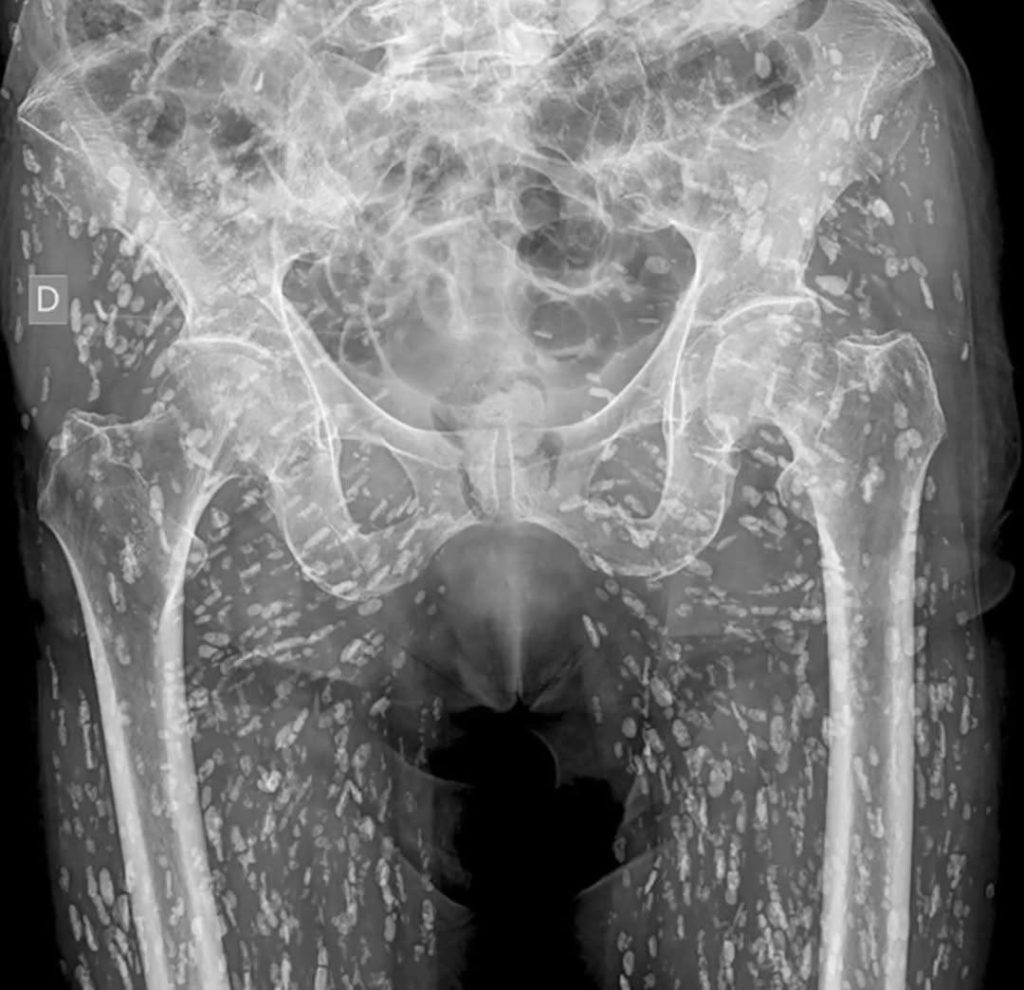Think pork is always safe as long as it looks good on your plate? Think again because a chilling real-life case involving a shocking X-ray has revealed the horrifying truth that eating raw or undercooked pork could quietly invite a dangerous parasite into your body, potentially turning into a life-threatening condition over time, so let’s break it down clearly so you know exactly what to avoid and how to keep yourself and your loved ones protected.

You may not have heard of Taenia solium, but trust me, your body definitely doesn’t want to meet it because this parasite, known as the pork tapeworm, can live inside pigs, and if the meat isn’t properly cooked, it can infect humans. What makes it even scarier is that the tapeworm doesn’t just stay in your gut; it can travel through your bloodstream and burrow into tissues throughout your body, causing a condition called cysticercosis. Cysticercosis happens when the tapeworm larvae escape your intestines and move into soft tissues like muscles, skin, and even the brain where they form cysts that over time calcify, turning into hard, rice grain–like shapes visible on X-rays, just like in one shocking case where a patient undergoing imaging for a hip injury accidentally revealed a body riddled with these calcified cysts, evidence of a long-term, undetected infection.
As creepy as that sounds, it gets worse when the larvae reach your brain, resulting in neurocysticercosis, a severe and potentially deadly neurological condition that can cause seizures, chronic headaches, cognitive impairment, muscle coordination issues, permanent neurological damage, and in extreme cases, death, so imagine walking around for years without knowing tiny invaders are silently setting up camp in your brain all because of one undercooked piece of pork. Many people wrongly believe that parasite infections are only a problem in remote villages or underdeveloped countries, but that’s completely false because global travel, imported meats, and trendy undercooked dishes make this a real threat no matter where you live, and since tapeworm eggs are invisible to the naked eye and infected pork can look and smell perfectly normal, you’re rolling the dice with every bite unless you take steps to protect yourself.
Now that you’re probably feeling a little concerned, let’s talk about what you can do to stay safe because the good news is that it’s not complicated—you just need to be smart. The first and most important rule is to cook pork thoroughly, making sure it reaches at least 145°F (63°C) internally followed by a three-minute rest period, and don’t rely on looks alone because a pork chop might appear done on the outside but still harbor live larvae inside, so always use a meat thermometer to be sure.
If you’re planning to eat pork raw or semi-raw, freezing it first can help by killing tapeworm eggs; keep it at -4°F (-20°C) for at least seven days for an added layer of protection. Practicing clean cooking is crucial too, meaning you must wash your hands thoroughly with hot water and soap after handling raw pork and disinfect all utensils, cutting boards, and surfaces. Avoid sketchy sources and only buy pork from trusted suppliers who meet food safety standards, and if the meat looks off, smells weird, or you can’t verify its origin, it’s better to skip it. If after eating pork you start feeling strange with unexplained headaches, confusion, or seizures, don’t hesitate—get checked immediately because an MRI or CT scan could reveal hidden cysts, and early treatment can make all the difference. Pork is undeniably delicious, from bacon and ribs to juicy pulled pork sandwiches, and the great news is you don’t have to give it up, but you do have to respect it because with proper preparation, pork becomes a safe and satisfying meal. With food trends glamorizing rare pork belly or raw pork sushi, it’s tempting to follow what’s trendy, but your health should always come first because no Instagram-worthy meal is worth risking your life. The X-ray case that revealed a body full of cysts wasn’t a fluke—it was a medical wake-up call that parasites don’t announce themselves but slip in quietly, often showing signs years or even decades later. In conclusion, pork can be a fantastic part of a healthy, protein-rich diet, but one wrong move in the kitchen could bring serious consequences, so next time you handle pork, fire up your thermometer, sanitize everything properly, and when in doubt, throw it out because your health is far more valuable than any undercooked meal.





